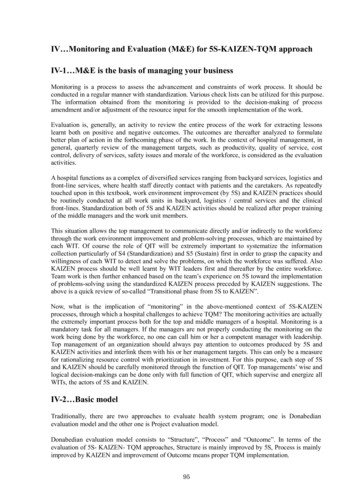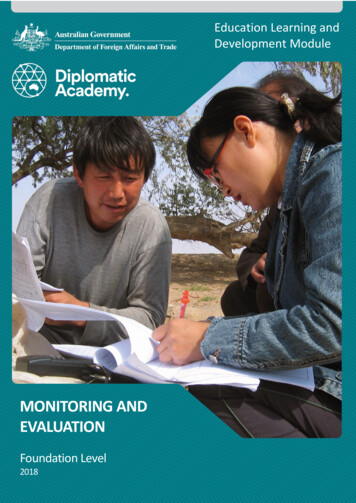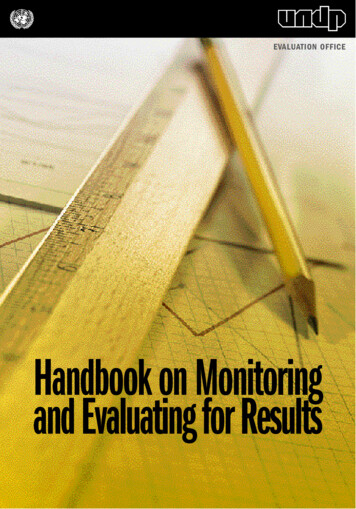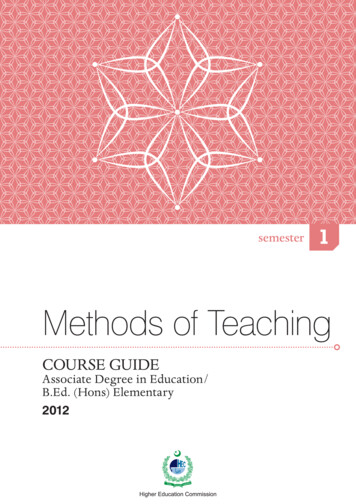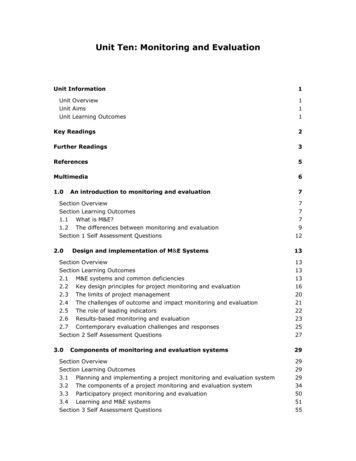
Transcription
Unit Ten: Monitoring and EvaluationUnit InformationUnit OverviewUnit AimsUnit Learning Outcomes1111Key Readings2Further Readings3References5Multimedia61.0An introduction to monitoring and evaluation7Section OverviewSection Learning Outcomes1.1 What is M&E?1.2 The differences between monitoring and evaluationSection 1 Self Assessment Questions7779122.0Design and implementation of M&E SystemsSection OverviewSection Learning Outcomes2.1 M&E systems and common deficiencies2.2 Key design principles for project monitoring and evaluation2.3 The limits of project management2.4 The challenges of outcome and impact monitoring and evaluation2.5 The role of leading indicators2.6 Results-based monitoring and evaluation2.7 Contemporary evaluation challenges and responsesSection 2 Self Assessment Questions3.0Components of monitoring and evaluation systemsSection OverviewSection Learning Outcomes3.1 Planning and implementing a project monitoring and evaluation system3.2 The components of a project monitoring and evaluation system3.3 Participatory project monitoring and evaluation3.4 Learning and M&E systemsSection 3 Self Assessment Questions13131313162021222325272929292934505155
P534Project Planning and ManagementUnit 10Unit Summary58Unit Self Assessment Questions59Key Terms and Concepts60 SOASCeDEP2
P534Project Planning and ManagementUnit 10UNIT INFORMATIONUnit OverviewThis unit explains the nature and purposes of project monitoring and evaluation (M&E),and the differences between these two complementary but distinct activities. Itdiscusses what can go wrong with project M&E systems and sets out a framework ofconcepts and principles that can aid the design and implementation of effective projectM&E. In doing so it provides the core of a ‘guidance manual’ or ‘handbook’ forprofessional work in this field. How to plan and implement a project M&E system isexplained in some detail through a review of the main steps and approaches required.The role of participation in M&E design and implementation is considered, and the unitconcludes with a discussion of how to create a learning environment for projectmanagers and for project implementation.Unit Aims To explain the principles, objectives and processes of project monitoring andevaluation. To provide guidelines on the principal requirements of a successful projectmonitoring and evaluation system. To present approaches to project monitoring and evaluation using the Logframe. To highlight results-based monitoring and evaluation and the key steps forimplementation. To set out the key principles for developing indicators. To provide sufficient understanding of the role of monitoring and evaluation inrural development, to be able to judge the effectiveness of existing project M&Esystems, and the appropriateness of proposed project M&E designs.Unit Learning OutcomesBy the end of this unit, students should be able to: understand conceptual frameworks, principles, and guidelines necessary for theeffective design and operation of project monitoring and evaluation systems understand what elements are essential to successful M&E, and what must beavoided SOASCeDEP1
P534Project Planning and ManagementUnit 10KEY READINGS IFAD (2002) Managing for Impact in Rural Development: A Guide for Project M&E.International Fund for Agricultural Development (IFAD), Rome, pp. 1–32.Available from: http://www.ifad.org/evaluation/guide/index.htmThis extract from a very useful and practical guide to M&E provides an overview of key conceptsand a guide to managing for impact using an adaptive management and learning approach. It ismore project focused than some recent guidelines for M&E which focus on sectoral managementin the public sector. It is thus more closely oriented to the needs of project managers in thefield. Rogers P (2009) Matching impact evaluation design to the nature of theintervention and the purpose of the evaluation In: Chambers R, Karlan D,Ravallion M, Rogers P (2009) Designing Impact Evaluations: DifferentPerspectives. Working Paper 4 of the International Initiative for Impact Evaluation(3ie), New Delhi, pp. 24–31.Available from: ers/workingpaper-4/This reading is the concluding part of a paper that considers how best to evaluate the impact ofthree different development interventions. (The complete paper is listed in the FurtherReadings section). The reading highlights the importance of selecting appropriate methods inthe design of impact evaluation. It argues that no single method for evaluating impact (whetherrandomized control trials, participatory approaches, or some other method) will be appropriatein all circumstances. Which method, or combination of methods, will be most suitable willdepend upon the answer to two important questions: ‘What is the nature of the intervention?’and ‘Why is an impact evaluation being done’. As you read, make notes on how answers tothese questions are likely to influence the method of impact evaluation. Make a note of thedifference between ‘simple’, ‘complicated’ and ‘complex’ projects and how each type willrequire a different approach to impact evaluation. Winters P, Maffioli A, Salazar L (2011) Introduction to the special feature:evaluating the impact of agricultural projects in developing countries. Journal ofAgricultural Economics 62(2) 393–402.This paper takes a look at the growing demand within the development profession for morerigorous evaluation of development interventions (especially through ‘randomized control trials’and other experimental and quasi-experimental methods) and considers the implications forevaluating the impact agricultural projects. It relates, in particular, to item (4) in Section 3.2 ofthis unit. Don’t worry too much about trying to understand the methods described in Section 4of the reading itself as these are beyond the scope of this unit. Concentrate instead on theparticular difficulties that are faced when trying to link cause and effect in agriculturalprojects. SOASCeDEP2
P534Project Planning and ManagementUnit 10FURTHER READINGSBravo-Ureta BE, Almeida AN, Solís D, Inestroza A (2011) The economic impact ofMarena’s investments on sustainable agricultural systems in Honduras. Journal ofAgricultural Economics 62(2) 429–448.Cavatassi R, Salazar L, González-Flores M, Winters P (2011) How do agriculturalprogrammes alter crop production? Evidence from Ecuador. Journal of AgriculturalEconomics 62(2) 403–428.Deaton A (2010) Instruments, randomization, and learning about development.Journal of Economic Literature 48(2) 424–455.Available from:http://www.princeton.edu/ pdfDel Carpio XV, Loayza N, Datar G (2011) Is irrigation rehabilitation good for poorfarmers? An impact evaluation of a non-experimental irrigation project in Peru.Journal of Agricultural Economics 62(2) 449–473.Dillon A (2011) do differences in the scale of irrigation projects generate differentimpacts on poverty and production? Journal of Agricultural Economics 62 (2) 474–492.IFAD (2002) Managing for Impact in Rural Development: A Guide for Project M&E.International Fund for Agricultural Development (IFAD), Rome.Available from: k JZ, Rist RC (2004) A Handbook for Development Practitioners. Ten Steps to aResults-based Monitoring and Evaluation System. The World Bank, Washington DC.Available eps2resultbasedMonitoring.pdfThis handbook provides a ‘how to’ guide for results-based monitoring and evaluation in thecontext of public sector management.OECD (2002) Glossary of Key Terms in Evaluating and Results-based Management.OECD/DAC, Paris.Available from: 04.pdf SOASCeDEP3
P534Project Planning and ManagementUnit 10Smutylo T (2005) Outcome Mapping: A Method for Tracking Behavioural Changes inDevelopment Programs. ILAC Brief 7, Institutional Learning and Change (ILAC),International Plant Genetic Resources Institute (IPGRI), Rome.Available from: -FINAL.pdfThis short briefing paper provides a summary of contemporary thinking about evaluation ofdevelopment projects and programmes that complements conventional use of logical frameworkanalysis and results-based management. Greater emphasis is placed on monitoring andevaluation of the processes by which development interventions are expected to achieveresults, and on the anticipated changes in attitudes, behaviour and relationships of the actorsand partners with which the intervention interacts.UNDP (2002) Handbook on Monitoring and Evaluating for Results. United NationsDevelopment Programme (UNDP) Evaluation Office, New York.Available Book/ME-Handbook.pdf SOASCeDEP4
P534Project Planning and ManagementUnit 10REFERENCESCaldwell R (2002) Project Design Handbook. CARE.Available ect Design Handbook CARE.pdf[Accessed 22 May 2013]Casley DJ, Kumar K (1987) Project Monitoring and Evaluation in Agriculture. TheWorld Bank, Washington DC.Deaton A (2010) Instruments, randomization, and learning about development.Journal of Economic Literature 48(2) 424–455.Available from:http://www.princeton.edu/ pdf[Accessed 22 May 2013]IFAD (2002) Managing for Impact in Rural Development: A Guide for Project M&E.International Fund for Agricultural Development (IFAD), Rome.Available from: essed 22 May 2013]Kusek JZ, Rist RC (2004) A Handbook for Development Practitioners. Ten Steps to aResults-based Monitoring and Evaluation System. The World Bank, Washington DC.OECD (2002) Glossary of Key Terms in Evaluating and Results-based Management.OECD/DAC, Paris.Available from: 04.pdf[Accessed 11 December 2013]Rogers P (2009) Matching impact evaluation design to the nature of the interventionand the purpose of the evaluation In: Chambers R, Karlan D, Ravallion M, Rogers P(2009) Designing Impact Evaluations: Different Perspectives. Working Paper 4 of theInternational Initiative for Impact Evaluation (3ie), New Delhi, pp. 24–31.Available from: ers/workingpaper-4/ [Accessed 22 May 2013]Smutylo T (2005) Outcome Mapping: A Method for Tracking Behavioural Changes inDevelopment Programs. ILAC Brief 7, Institutional Learning and Change (ILAC),International Plant Genetic Resources Institute (IPGRI), Rome. SOASCeDEP5
P534Project Planning and ManagementUnit 10Turrall S, Pasteur K (2006) Pathways for Change: Monitoring and Evaluation.Learning from the Renewable Natural Resources Research Strategy. DFID.Available aticSummaries/Brief3 Pathways for change monitoring%20and%20evaluation.pdf [Accessed 22 May 2013]UNDP (2002) Handbook on Monitoring and Evaluating for Results. United NationsDevelopment Programme (UNDP) Evaluation Office, New Book/ME-Handbook.pdf20 December 2013][AccessedWoodhill J (2006) Monitoring & evaluation as learning: rethinking the dominantparadigm. Sustaining livelihoods in Sub-Saharan Africa Newsletter, Issue 21, AfricanInstitute for Community Driven Development.Available from: arning-rethinkingdominant-paradigm [Accessed 22 May 2013]World Bank IEG (2007) Water Management in Agriculture: Ten Years of World BankAssistance, 1994–2004. The World Bank Independent Evaluation Group (IEG),Washington DC.Available 006133D7 [Accessed 22 May 2013]MULTIMEDIACGD (2011) Impact Evaluations and the 3ie: William Saveoff. Global ProsperityWonkast Center for Global Development. Duration: 22 minutes.Audio file available from:http://blogs.cgdev.org/global prosperity william-savedoff/Podcast on the growing interest in rigorous impact evaluations of development interventions. SOASCeDEP6
P534Project Planning and ManagementUnit 101.0 AN INTRODUCTION TO MONITORING AND EVALUATIONSection OverviewThis section introduces this unit by explaining the nature and purposes of projectmonitoring and evaluation, and the differences between these two complementary butdistinct activities.Section Learning OutcomesBy the end of this section, students should be able to: understand what M&E is, and the difference between monitoring, and evaluation have an awareness of why M&E is important1.1What is M&E?M&E is a process of continual gathering of information and assessment of it in order todetermine whether progress is being made towards pre-specified goals and objectives,and to highlight whether there are any unintended (positive or negative) effects from aproject and its activities. It is an integral part of the project cycle and of goodmanagement practice.In broad terms, monitoring is carried out in order to track progress and performance asa basis for decision-making at various steps in the process of an initiative or project.Evaluation, on the other hand is a more generalised assessment of data or experience toestablish to what extent the initiative has achieved its goals or objectives. Before you read on, list some of the key reasons why you think M&E iscarried out?M&E is carried out for many different purposes.Monitoring systems provide managers and other stakeholders with regular informationon progress relative to targets and outcomes. This enables managers to keep track ofprogress, identify any problems, alter operations to take account of experience, anddevelop any budgetary requests and justify them. This enables the early identification ofproblems so that solutions can be proposed. It is considered to be a critical part of goodmanagement.Periodic evaluation is also considered to be good practice, and can be used to investigateand analyse why targets are or are not being achieved. It looks at the cause and effectof situations and trends which are recorded within monitoring. SOASCeDEP7
P534Project Planning and ManagementUnit 10Periodic and formal evaluation are vital for internal reporting and auditing, and are alsorequested by funding agencies – often as mid-term and final evaluations. Externalstakeholders and funding agencies who are accountable to donors or are part of thepublic sector, need to see results and demonstrable impacts.However, it should be recognised that ongoing or ‘informal’ evaluation should always beavailable as a tool to managers, not only to meet the requirements of governments anddonors, but also as a means of understanding when and why things are going right orwrong during project implementation.M&E is also important for incorporating the views of stakeholders, particularly the targetpopulation and can be a further mechanism to encourage participation and increasedownership of a project.Thus, the key reasons for M&E can be summarised under four headings.(1) For accountability: demonstrating to donors, taxpayers, beneficiaries andimplementing partners that expenditure, actions and results are as agreed or canreasonably be expected in the situation.(2) For operational management: provision of the information needed to co-ordinatethe human, financial and physical resources committed to the project orprogramme, and to improve performance(3) For strategic management: provision of information to inform setting andadjustment of objectives and strategies.(4) For capacity building: building the capacity, self-reliance and confidence ofbeneficiaries and implementing staff and partners to effectively initiate andimplement development initiatives.Monitoring and evaluation should be evident throughout the lifecycle of a project, as wellas after completion. It provides a flow of information for internal use by managers, andfor external use by stakeholders who expect to see results, want to see demonstrableimpacts, and require accountability and trustworthiness on the part of the public sector.Governments and organisations are accountable to stakeholders and this requires themto both achieve expected outcomes and be able to provide evidence that demonstratesthis success. As a consequence increasing attention is now being given to fundingrigorous impact evaluations that are capable of providing solid empirical evidence aboutwhether or not a particular type of development intervention works. Producing thisevidence is technically challenging and expensive and won’t be feasible for all or eventhe majority of projects. Nevertheless, as a vehicle of policy research it can, whenapplied to particular kinds of project, help inform decisions about how to allocateresources between different types of intervention, and between different project designs.The demand for rigorous impact evaluation clearly has implications for the design of M&Esystems, and is most likely to be met if the project and associated M&E system aredesigned with this rigour in mind from the outset. SOASCeDEP8
P534Project Planning and ManagementUnit 10Monitoring and evaluation of projects can be a powerful means to measure theirperformance, track progress towards achieving desired goals, and demonstrate thatsystems are in place that support organisations in learning from experience and adaptivemanagement.Used carefully at all stages of a project cycle, monitoring and evaluation can help tostrengthen project design and implementation and stimulate partnerships with projectstakeholders.At a sector level monitoring and evaluation can: improve project and programme design through the feedback provided from midterm, terminal and ex post evaluations inform and influence sector and country assistance strategy through analysis ofthe outcomes and impact of interventions, and the strengths and weaknesses oftheir implementation, enabling governments and organisations to develop aknowledge base of the types of interventions that are successful (ie what works,what does not and why) provide the evidential basis for building consensus between stakeholdersAt project level monitoring and evaluation can: provide regular feedback on project performance and show any need for ‘midcourse’ corrections identify problems early and propose solutions monitor access to project services and outcomes by the target population; evaluate achievement of project objectives measure the impact of the project on various indicators (including those relating toproject objectives and other areas of concern) incorporate pation,ownershipandThe differences between monitoring and evaluationIt is useful to explore the differences between ’monitoring’ and ‘evaluation’ in moredepth. Some concise definitions are provided in 1.2.1, below. SOASCeDEP9
P534Project Planning and ManagementUnit 101.2.1 Definitions of monitoring and evaluationMonitoring is the continuous collection of data on specified indicators to assess for adevelopment intervention (project, programme or policy) its implementation in relation toactivity schedules and expenditure of allocated funds, and its progress and achievements inrelation to its objectives.Evaluation is the periodic assessment of the design, implementation, outcomes and impactof a development intervention. It should assess the relevance and achievement ofobjectives, implementation performance in terms of effectiveness and efficiency, and thenature, distribution and sustainability of impacts.Source: unit author, (adapted from OECD (2002), Casley and Kumar (1987)It is clear that monitoring and evaluation are different yet complementary. Monitoringis the process of routinely gathering information with which to make informed decisionsfor project management. Monitoring provides project managers with the informationneeded to assess the current project situation and assess where it is relative tospecified targets and objectives – identifying project trends and patterns, keepingproject activities on schedule, and measuring progress toward expected outcomes.Monitoring can be carried out at the project, programme or policy levels.Monitoring provides managers and other stakeholders with regular information onprogress relative to targets and outcomes. It is descriptive and should identify actual orpotential successes and problems as early as possible to inform management decisions.A reliable flow of relevant information during implementation enables managers to keeptrack of progress, to adjust operations to take account of experience and to formulatebudgetary requests and justify any needed increase in expenditure. Indeed, an effectivemanagement information system that performs these functions is an essential partof good management practice.Evaluation, on the other hand, gives information about why the project is or is notachieving its targets and objectives. Some evaluations are carried out to determinewhether a project has met (or is meeting) its goals. Others examine whether or not theproject hypothesis was valid, and whether or not it addressed priority needs of thetarget population. Depending on the purpose of a particular evaluation, it might assessother areas such as achievement of intended goals, cost-efficiency, effectiveness, impactand / or sustainability. Evaluations address: ‘why’ questions, that is, what caused thechanges being monitored; ‘how’ questions, or what was the sequence or process that ledto successful (or unsuccessful) outcomes; and ‘compliance and accountability’ questions,that is, did the promised activities actually take place and as planned? Evaluations aremore analytical than monitoring, and seek to address issues of causality. A baselinestudy is the first phase of a project evaluation. It is used to measure the ‘starting orreference points’ of indicators of effect and impact.Frequent evaluation of progress is good management practice. It seeks to establishcausality for the situations and trends recorded by monitoring. Clearly evaluation shouldrespond when monitoring identifies either problems or opportunities to enhanceachievements. Managers should use evaluation results to make adjustments to the SOASCeDEP10
P534Project Planning and ManagementUnit 10design and implementation of their project or other interventions. Periodically this canbe formalised to involve the recipient government and donor in one or more formalreviews such as a mid-term evaluation. Terminal evaluations are similarly formalisedand typically conducted at the end of the intervention to provide the information forcompletion reports. An ex post evaluation may be completed a further period aftercompletion, when it is reasonable to expect the full impacts of the intervention to havetaken place.Ongoing, ‘process’ or informal evaluation occurs during the course of the project as partof good management practice to assess activities or functions and to makerecommendations for improving project implementation. Summative evaluations arecarried out at the end of a funding period to assess positive and negative impacts andexamine the effectiveness of a project. These are often termed ‘impact assessments’.Lessons learned from final evaluations should contribute to the formation of futureprojects and programs.Such formalised and periodic evaluations are important for the internal reporting andauditing procedures of the organisations involved, and as a means to documentexperience and feed back into the planning of future interventions. It should berecognised, however, that evaluation is always available as a mode of analysis that canhelp managers and other stakeholders to understand all aspects of the work at hand.This applies from design stages, through implementation and on to completion and finaloutcomes. The terms ‘informal’ or ‘ongoing’ evaluation can be used to describeevaluation that is conducted primarily by managers themselves as a key part of effectivemanagement and project implementation.Project level M&E systems should overlap with and feed into public sector managementinformation systems. These generally place emphasis on the use of information streamsthat are more or less continuous, and which can be trusted and used in real time fordecision-making.When monitoring and evaluation is effective knowledge should accumulate in theexperience and expertise of staff, in the documented institutional memory of theorganisation and its partners, and in their planning and management procedures.Section Summary The section explained why monitoring and evaluation are important and definedthese concepts and the differences between them. SOASCeDEP11
P534Project Planning and ManagementUnit 10Section 1 Self Assessment QuestionsQuestion 1True or false?(a) Monitoring is useful for identifying problems early within the progress of a project.(b) Impact assessment can be considered to be a type of evaluation.(c) Evaluation can only be carried out at the mid-way point and end of a project.Question 2List ten complementary roles that monitoring and evaluation can play – five formonitoring and five for evaluation. SOASCeDEP12
P534Project Planning and Management2.0Unit 10DESIGN AND IMPLEMENTATION OF M&E SYSTEMSSection OverviewThis section explains what can go wrong with project M&E systems and sets out aframework of concepts and principles that can aid the design and implementation ofeffective project M&E. It provides the core of a guidance manual or handbook forprofessional work in this field.Section Learning OutcomesBy the end of this section, students should be able to: understand the M&E systems and their relation to the logical framework analysis be familiar with the challenges of M&E and the concepts of results-basedmanagement2.1M&E systems and common deficienciesA monitoring and evaluation system is made up of the set of interlinked activities thatmust be undertaken in a co-ordinated way to plan for M&E, to collect and analyse data,to report information, and to support decision-making and the implementation ofimprovements. Think to yourself for a few moments about what you think constitutes themain aspects of an M&E system for a rural development project.The key parts of an M&E system are succinctly set out in 2.1.1.2.1.1 The six main components of a project M&E system– Clear statements of measurable objectives for the project and its components.– A structured set of indicators covering: inputs, process, outputs, outcomes, impact, andexogenous factors.– Data collection mechanisms capable of monitoring progress over time, includingbaselines and a means to compare progress and achievements against targets.– Where applicable building on baselines and data collection with an evaluation frameworkand methodology capable of establishing causation (ie capable of attributing observedchange to given interventions or other factors).– Clear mechanisms for reporting and use of M&E results in decision-making.– Sustainable organisational arrangements for data collection, management, analysis, andreporting.Source: unit author SOASCeDEP13
P534Project Planning and ManagementUnit 10The design of an M&E system should start at the same time as the overall projectpreparation and design, and be subject to the same economic and financial appraisal, atleast to achieve the least-cost means of securing the desired objectives. Such practicehas been followed for projects in recent years. Problems arose with earlier M&E systemsthat were set up after the project had started. Often this was left to management alone,who by that time already had too much to grapple with and could not provide sufficienttime, resources or commitment.The ‘supply side’ of M&E design should not be overlooked. Skilled and well-trainedpeople are required for good quality data collection and analysis. They may be a veryscarce resource in developing countries, and should be ‘shadow-priced’ accordingly whenappraising alternative M&E approaches. It is inevitable that the system designed will notbe as comprehensive as is desirable, and will not be able to measure and record all therelevant indicators. It is here that the project analyst must use the tools of economicappraisal, and judgment based on experience, to find the best compromise.Evaluations of existing M&E systems by agencies have shown certain commoncharacteristics, weaknesses, and recurrent problems which are important causes ofdivergence between the theory of M&E and actual practice in the field. These are worthbringing to the attention of both designers and operators of M&E systems, as problemsto be avoided in the future: poor system design in terms of collecting more data than are needed or can beprocessed inadequate staffing of M&E both in terms of quantity and quality missing or delayed baseline studies. Strictly these should be done before the startof project implementation, if they are to facilitate with and without projectcomparisons and evaluation delays in processing data, often as a result of inadequate processing facilities andstaff shortages. Personal computers can process data easily and quickly but tomake the most of these capabilities requires the correct software and capable staff delays in analysis and presentation of results. These are caused by shortages ofsenior staff, and by faulty survey designs that produce data that cannot be used.It is disillusioning and yet common for reports to be produced months or yearsafter surveys are carried out when the data have become obsolete and irrelevant.This is even more the case when computer printouts or manual tabulations ofresults lie in offices, and are never analysed and written up finally, even where monitoring is e
rigorous evaluation of development interventions (especially through 'randomized control trials' and other experimental and quasi-experimental methods) and considers the implications for evaluating the impact agricultural projects.

